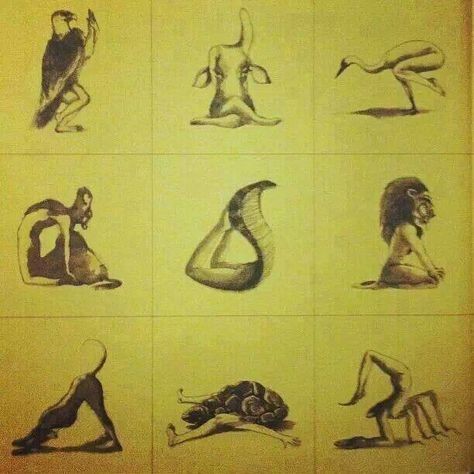Asana- To be (established/seated in)
The yoga sutra of Patanjali puts asana at the third rung of the eight steps of yoga. The first two being the Yama(social ethical codes) and Niyama(self discipline). In not so far history, an aspirant of yoga was to be deemed worthy of learning yoga before being allowed into the practice of asana. This is called Paatrata(worthiness). An aspiring student of yoga had to first know and display in his/ her conduct an observance of the Yama and niyama before being introduced to the further steps of yoga.
The introductory verse of Patanjali Yoga Sutra PYS 1:2 describes yoga as yogas chitta vritti niruddh..cessation of the movement of the thought patterns on the mind complex. The sutras in chapter two (Sadhana-pad= methodology) go on to explain asana as
Sthira Sukham Asanam PYS 2:46Sthira (stable) sukham(comfortable) asanam (is asana ) (PYS 2:46)
Prayatnashaithilya (relaxation of effort) anantasamapattibhyam (merging with the Infinite) PYS 2:47
Asana is an assumed pose rather than a forceful pose. No forced fighting with the body, but gently and firmly getting into the pose with awareness and to the best capablity of the body. By using the mind through breath awareness(prana dharana) during Asana practice, this furthers to bring a quiet steadiness of the body in the pose creating the connection with the soul. That, in which one is firmly established is defined as asana.This can now be looped back to the introductory Yoga chitta vritti niruddha (PYS1:2) as only a physically steadily held posture can aid a stable mind in meditation. Thus, the purpose of yogaAsana is to establish a balanced and stable physio-psychological connect to continue towards the inner yoga in the last four steps of Ashtanga(the eight limbs) yoga as collated by Patanjali.
Yoga aims to bring into balance the breath of both the nostrils, the left nostril is the moon channel Ida and denoted as the parasympathetic system while the right nostril is the sun channel Pingala and denotes the sympathetic system. If yogasana is performed with force and a strained mind, the balance is broken and purpose defeated.
The word yoga is nowadays used to denote Asana practice. Yoga is not kinetic exercise. Yogasana has unfortunately been turned upside down(pun intended), subject to marketing gimmicks of six pack abs, dynamic, hot, power yoga, acro yoga on beaches, and way too many derogatory derivatives created by distended egos. Yoga instructors are focused on anatomy and instructing students to apply effort to push and pull up glutes, align body parts while dropping the trapezius muscle and go mindcrazy instead of gently bringing awareness and quietitude into asana. Yoga Teacher training programs take the easy route to study of asana as anatomical impact instead of the focus on true yoga as a philosophy that is related to psychology. Teacher training certification yoga schools in India even have an entire module dedicated to study scientific musculoskeletal anatomy that would be better off in a physiotherapy class. Can you imagine ancient yoga gurus in India using a skeleton to explain yogic anatomy to their students? Is this the yoga that India of today has to offer? The culture of this country has attracted many because yoga is woven into it and spirituality is integrated within its very fabric. Yoga is well applied as physical therapy taking into cognisance its application at all levels of the mind, body and soul. To reduce it to the physical muscular level is gross ineptitude and negligence of duty as a yogacharya(teacher of yoga).
Even while writing this, the scientific world announced a 'new' organ system discovery, and called it the interstitium. The ancient Rishis already knew about Nadis which are yet to be anatomically found and validated. So how does the detailed study of scientific anatomy measure up to the study of yogic physiology? While it is good to know both, and a basic study of anatomy and the scientific working of the human body constituted a small part of my initial introductory study too, I'm grateful that my teachers taught me more of the yogic physiology. The anatomy curriculum didn't take up more than one sixth of the curriculum. While, non science stream students may need an introduction to anatomy and systems of the human body study, the focus remained on the yogic than the anatomical. The yoga certification bodies and gym culture that have hijacked yoga have underplayed if not totally misinterpreted the true purpose of the Asana part to create the connection of the mind body and soul. Yes, Soul.
Tradition has it that there are 84 asanas that are a derivative of the 84 lac yonis(birth channels/species). According to the Vedas, there are 8.4 million species of life and the conditioned soul which is immortal is continuously passing through the different species according to its Karma accumulated or spent in those particular births. The 8.4 million species of life are divided into six groups, namely acquatics, trees, insects, birds, animals and humans.
ACQUATICS/Jalaja – 0.9 million
TREES /Sthavara – 2.0 million
INSECTS, MICROBES, REPTILES /Krimayo – 1.1 million
BIRDS/ Pakshinam – 1.0 million
ANIMALS/ Pashavah – 3.0 million
HUMANS/ Manavah – 0.4 million
TOTAL - 8.4 million
When Paramahansa Dandi Swami gives his version on the definition of the last, humans, he says that all the monkeys and humans are included in the 0.4 million(Darwin wasn't so off his theory after all). The great soul then goes on to ask as to how to differentiate the monkeys and humans. After a pause, he enlightens the audience - Vanar woh jo man se chale, Manav woh jo Narayan ki aor chale: Monkeys will act as per their mind's will and humans will use the mind to move towards the Divine. Now, the connection of the Asana to the cycle of rebirth and connection to the soul. The soul identifies with the samskara(impressions in the subconscious mind) due to karmas of its past incarnations - Asana helps in the working out of those samskara. Note how certain asana feel like home and certain are sheer work to get through. For example, someone could hold the tree pose(vrkshasana) forever yet struggle to hold the bird asana(bakasana) although both are categorised as balancing asanas. Samskara manifest in the psychophysiology as tight muscles, physical limitations or fears and asana creates that drawing board to address them out on to clear the path for the souls progress. Yogasana is a path of the soul that uses the bodily posture to arrive at the experience of the soul's connection to the universal consciousness. .
Ayurvedic regimen recommends exercise that is to be performed without exerting and being short of breath. It is advised that exercise should be stopped when one has to breathe quickly with a dry sensation in mouth and when perspiration appears on the forehead. At this point, if exercise is continued, bodily secretions will exude and leave the gastrointestinal tract to adversely affect other bodily sites. Musculoskeletal exertions cause hepatic, splenic or mesentric reserves to empty into the peripheral circulation leading to undigested products in the tissues and thus creating disease. Ayurveda evaluates physical ability not on the basis of muscle size or 'body beautiful' but on the capacity to withstand heat, cold, hunger thirst or fatigue. This is where Yogasana as a complete discipline with emphasis on diet restrictions and behaviour(Yama & Niyama) come into the framework of holistic exercise. While exercise in itself is good, ethically not calling it yoga would be a good start.
Asana lessons at Kaivalyadhama : "ASSUME the ASANA"= become the asana. Thank you Sandhya Ji for drilling in that phrase and teaching to hold effortlessly for a minimum of twelve minutes
Yogasana are not exercises, but techniques which place the physical body in positions that cultivate awareness, relaxation, concentration and meditation … the body becomes full of vitality and strength, the mind becomes light, creative, joyful and balanced – Satyananda Saraswati



